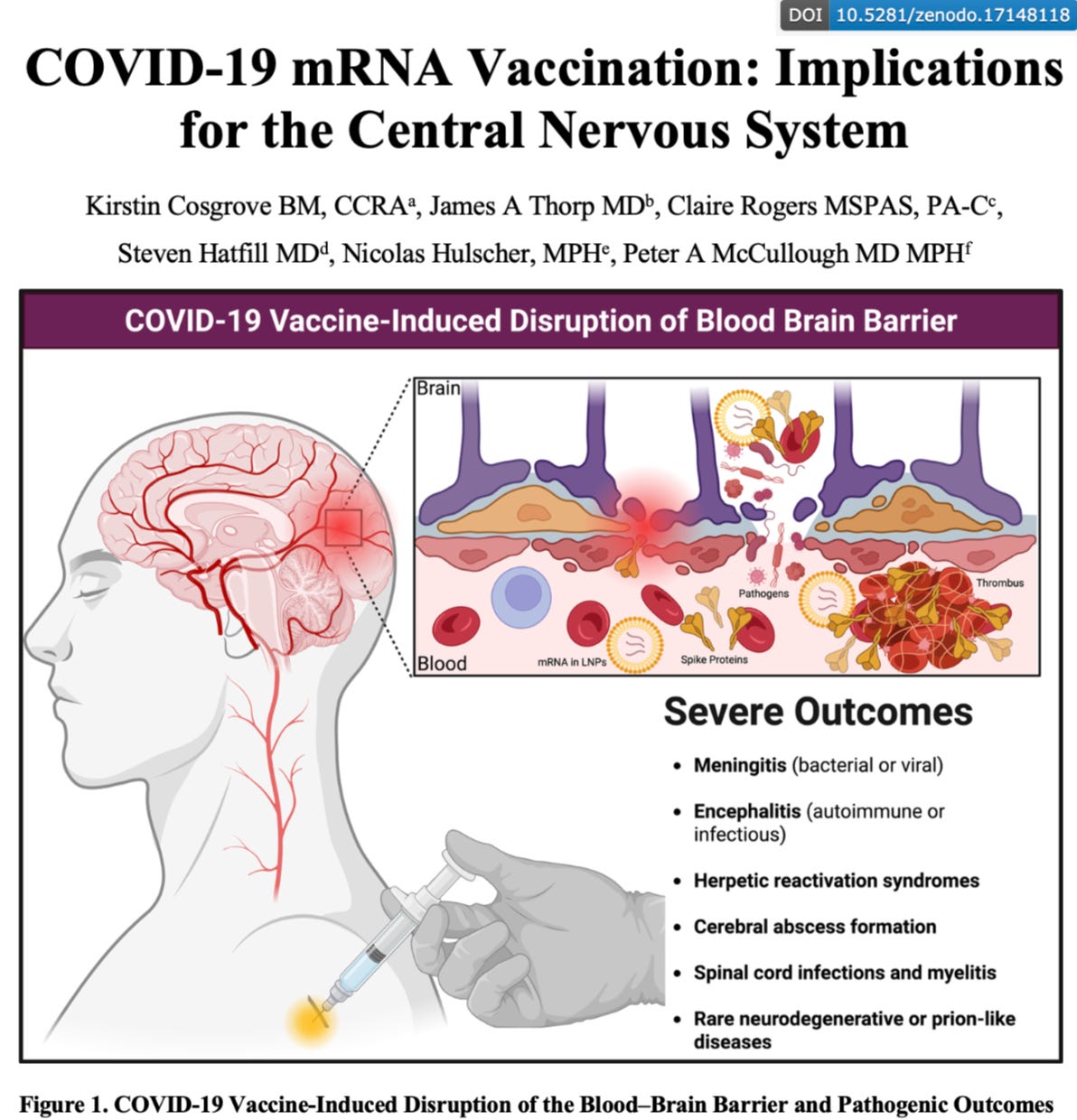BREAKING STUDY: COVID-19 "Vaccines" Linked to 63 Serious Central Nervous System Adverse Events
The study titled “COVID-19 mRNA Vaccination: Implications for the Central Nervous System,” authored by Kirstin Cosgrove, BM, CCRA; James A. Thorp, MD; Claire Rogers, MSPAS, PA-C; Steven Hatfill, MD; Nicolas Hulscher, MPH; and Peter A. McCullough, MD, MPH, has just been uploaded to Zenodo.
Using VAERS data from January 1990 through November 2024, we compared adverse events reported after COVID-19 vaccination to those after influenza vaccination and all other vaccines combined. We focused specifically on the central nervous system (CNS) — the brain and spinal cord, which control everything from memory and thought to movement and vital body functions. In total, we identified 63 serious safety signals involving the brain and nervous system, ranging from meningitis and encephalitis to brain abscesses, herpesvirus reactivations, demyelinating syndromes, and even prion diseases — each breaching CDC/FDA thresholds that are supposed to trigger immediate safety investigations.
The mechanism is clear: lipid nanoparticles deliver mRNA into brain blood vessels, where spike protein is produced and drives vascular inflammation. This damages the blood–brain barrier (BBB), the brain’s protective shield, and allows pathogens and latent viruses to penetrate, bacteria to seed abscesses, and immune responses to misfire against neural tissue. Spike protein itself can also cross into the brain, where it disrupts neurons and glial cells and promotes abnormal protein misfolding — a prion-like process resembling Creutzfeldt–Jakob disease and “mad cow disease.” Together, these effects explain why COVID-19 vaccination is associated with such a broad spectrum of severe neurological injuries.

Here are the conditions we found to be far more likely to be reported after COVID-19 vaccination compared to flu or other vaccines:
Meningitis (all types) — OR 34.2 (23.7–50.0), p<0.0001 → 34× more likely than after flu vaccination
Aseptic meningitis — OR 52.8 (33.5–83.1), p<0.0001 → 53× more likely
Bacterial meningitis — OR 35.7 (16.7–76.0), p<0.0001 → 36× more likely
Autoimmune encephalitis — OR 78.9 (45.4–137), p<0.0001 → 79× more likely
Limbic encephalitis — OR 146 (43.7–485), p<0.0001 → 146× more likely
Bickerstaff’s encephalitis — OR 68.3 (19.8–236), p<0.0001 → 68× more likely
Neuroborreliosis (Lyme CNS infection) — OR 321 (43.0–2390), p<0.0001 → 321× more likely
Toxic encephalopathy — OR 157 (69.1–355), p<0.0001 → 157× more likely
Progressive multifocal leukoencephalopathy (PML) — OR 44.6 (9.48–210), p<0.0001 → 45× more likely
Herpes zoster meningitis — OR 1,260 (77.0–20,700), p<0.0001 → over 1,200× more likely
Herpes zoster meningoencephalitis — OR 339 (45.5–2,520), p<0.0001 → 339× more likely
Herpes zoster neurological disease — OR 680 (41.1–11,200), p<0.0001 → 680× more likely
Herpes simplex meningitis — OR 132 (7.45–2,360), p=0.0009 → 132× more likely
Herpetic meningoencephalitis — OR 136 (47.3–391), p<0.0001 → 136× more likely
Varicella meningitis — OR 168 (9.61–2,930), p=0.0004 → 168× more likely
Brain abscess — OR 120 (27.7–522), p<0.0001 → 120× more likely
Extradural abscess — OR 169 (22.2–1,290), p<0.0001 → 169× more likely
Spinal cord abscess — OR 89.1 (11.2–712), p<0.0001 → 89× more likely
Subdural abscess — OR 35.7 (3.90–326), p=0.0015 → 36× more likely
Creutzfeldt–Jakob disease (CJD) — OR 847 (115–6,220), p<0.0001 → 847× more likely
Myelitis (all types) — OR 31.3 (22.2–44.2), p<0.0001 → 31× more likely
Transverse myelitis — OR 20.8 (15.0–29.0), p<0.0001 → 21× more likely
Viral myelitis — OR 115 (6.37–2,070), p=0.0013 → 115× more likely
Noninfectious myelitis — OR 132 (7.45–2,360), p=0.0009 → 132× more likely
Prion disease (general) — OR 61.8 (3.15–1,220), p=0.0066 → 62× more likely
These findings demonstrate that COVID-19 vaccination not only compromises the integrity of the blood–brain barrier but initiates a cascade of neuropathological processes. In addition to facilitating infections and inflammatory injury, the spike protein exhibits prion-like behavior — misfolding and inducing aberrant protein aggregation consistent with mechanisms underlying Creutzfeldt–Jakob disease, the human analogue of bovine spongiform encephalopathy (“mad cow disease”). Such prionogenic activity may also contribute to the formation of the anomalous white fibrous intravascular clots reported postmortem, where amyloid and fibrin deposition suggest a novel, vaccine-associated pathology of protein misfolding.
This unprecedented neurological disruption also helps to explain why another study by Thorp et al found that mRNA shots were linked to 86 serious neuropsychiatric disorders including dementia, schizophrenia, suicidal and homicidal thoughts, stroke, psychosis, depression, cognitive impairment, delusions, and more:

Taken together, disruption of the brain’s vascular defenses and induction of prion-like processes represent a profound and urgent neurological safety concern.
As we conclude in the study:
All safety signals reported are concerning and support an immediate global ban on the COVID-19 vaccination program.
Epidemiologist and Foundation Administrator, McCullough Foundation
Support our mission: mcculloughfnd.org
Please consider following both the McCullough Foundation and my personal account on X (formerly Twitter) for further content.